To master moving subject focus on your mobile camera, start by understanding your subject's motion and speed. Use pre-focus techniques like locking focus and recomposing for quick shots. Enable continuous autofocus mode for subjects in constant motion. Utilize burst mode to capture multiple frames, increasing your chances of getting the perfect shot. Try panning to create dynamic images with sharp subjects and blurred backgrounds. Adjust shutter speed in manual mode to freeze action or show motion blur. Finally, practice using focus lock features for precise control. These pro tips will elevate your mobile photography game, but there's always more to explore in the world of smartphone cameras.
Understanding Subject Motion
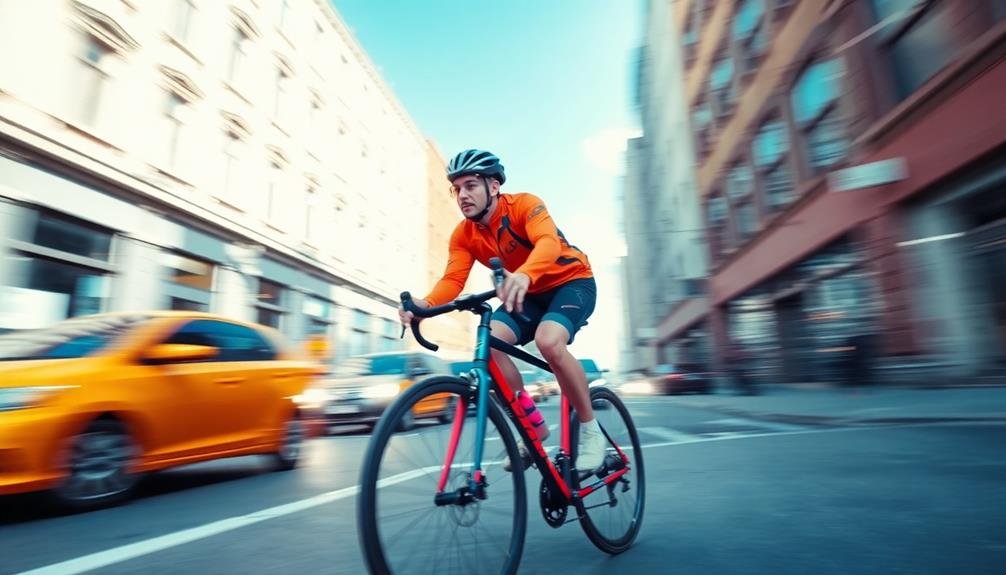
When it comes to capturing moving subjects with your mobile camera, you'll need to get a handle on subject motion. Understanding how your subject moves is essential for achieving sharp, well-focused images. Start by observing the speed and direction of your subject. Is it moving quickly or slowly? In a straight line or erratically?
Next, consider the angle of motion relative to your camera. Subjects moving parallel to your lens are easier to track than those coming directly towards or away from you. Pay attention to predictable patterns in movement, like a runner's stride or a cyclist's pedaling rhythm.
Anticipate your subject's next move and position yourself accordingly. This foresight allows you to frame your shot before the action unfolds. Practice panning techniques to follow your subject smoothly, matching their speed with your camera movement.
Remember that different subjects require different approaches. For fast-moving objects, you'll need quicker reflexes and possibly burst mode. Slower subjects give you more time to compose and focus.
Pre-focus Techniques for Quick Shots
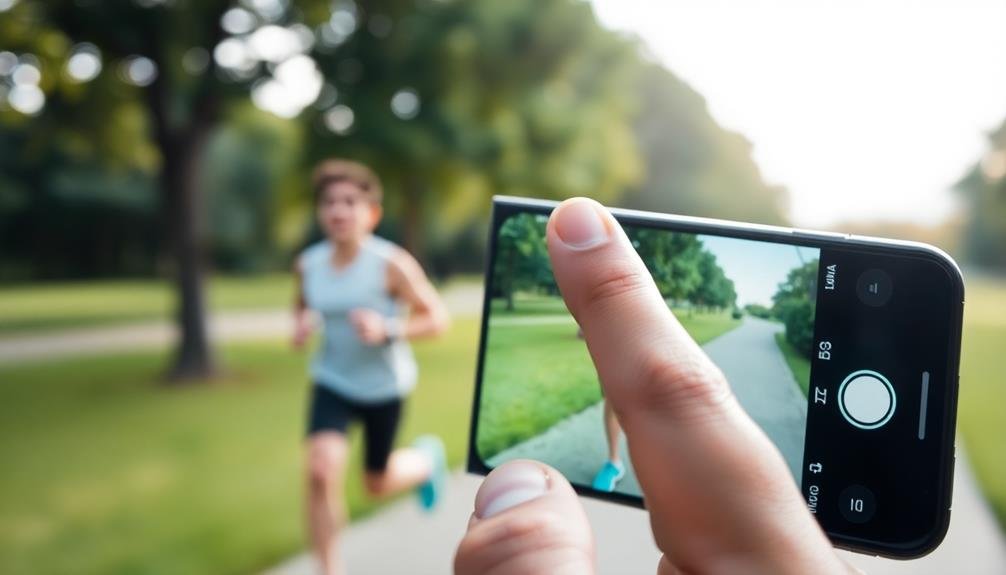
To capture quick shots effectively on your mobile device, you'll want to master pre-focus techniques.
Start by learning to lock focus and recompose, which allows you to set your focus point and then adjust your framing.
Explore your camera app's focus peaking feature to highlight in-focus areas, and practice zone focusing to preset your focus for anticipated shot distances.
Lock Focus and Recompose
Capturing fleeting moments requires speed and precision. The lock focus and recompose technique can help you achieve this with your mobile camera.
To use this method, first tap on your subject to focus. Once focused, press and hold your finger on the screen until you see a focus lock indicator (usually AE/AF LOCK). This locks both focus and exposure.
Now, you're free to recompose your shot without losing focus on your subject. Simply move your phone to frame the image as desired. When you're ready, tap the shutter button to capture the photo.
This technique is particularly useful for off-center compositions or when your subject is near the edge of the frame.
Use Focus Peaking
Ever wondered how professional photographers achieve tack-sharp focus so quickly? One of their secret weapons is focus peaking, a powerful tool now available on many mobile cameras.
Focus peaking highlights the sharpest areas of your image in real-time, allowing you to quickly identify and lock onto your subject.
To master focus peaking for moving subjects:
- Enable focus peaking in your camera app's settings
- Choose a contrasting highlight color for easy visibility
- Pre-focus on your subject's expected position
- Adjust your focus as the subject moves, keeping an eye on the highlighted areas
As your subject moves, you'll see the focus peaking highlights shift. This visual feedback helps you maintain sharp focus even with fast-moving subjects.
Practice tracking subjects at different speeds, adjusting your technique as needed. Remember, focus peaking works best in manual focus mode, giving you full control over your shots.
Zone Focusing Method
Street photography's fast-paced nature demands quick reactions and even quicker focusing. That's where zone focusing comes in handy. This technique involves pre-focusing your camera to a specific distance, allowing you to capture sharp images without adjusting focus for each shot.
To use zone focusing, first estimate the distance where most of your subjects will be. Set your camera's focus to this distance manually. Then, choose a narrow aperture (higher f-number) to increase depth of field, ensuring a wider range of subjects remain in focus.
With your camera pre-focused, you're ready to shoot instantly. As subjects enter your pre-focused zone, snap away without worrying about autofocus lag. This method works particularly well for street scenes, where subjects often appear at predictable distances.
Practice estimating distances and memorizing your lens's focus scale to master zone focusing. Start with wider lenses, as they offer more depth of field. As you gain confidence, experiment with different focal lengths and apertures.
Continuous Autofocus Mode Explained
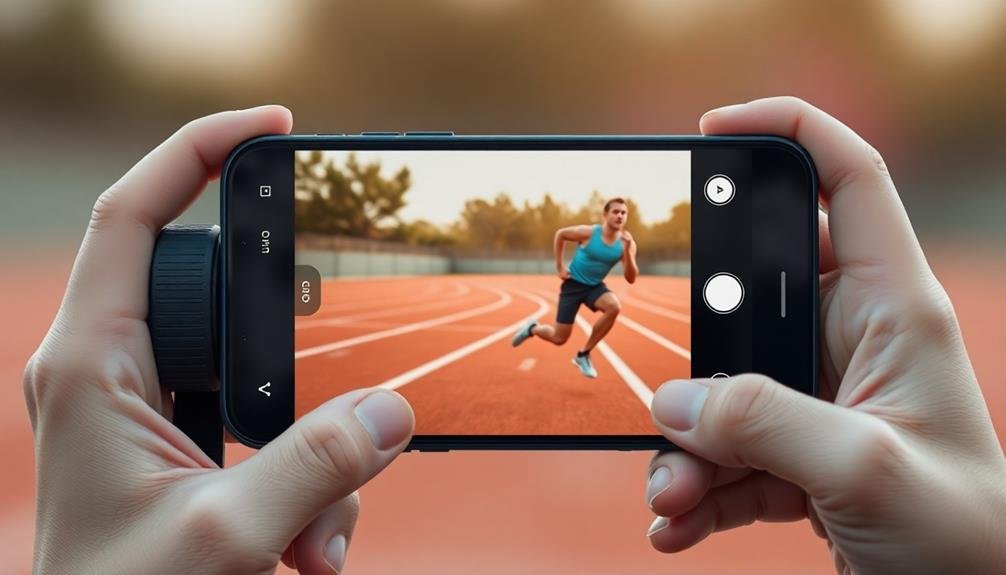
Continuous autofocus mode keeps your camera constantly adjusting focus as your subject moves.
You'll find this feature particularly useful when capturing fast-moving subjects like sports or wildlife.
While it can drain your battery faster and may occasionally focus on the wrong element, continuous AF offers the advantage of tracking moving subjects with greater accuracy.
How Continuous AF Works
With modern smartphones, capturing sharp images of moving subjects has become easier thanks to Continuous Autofocus (AF) mode. This feature constantly adjusts the focus as your subject moves, ensuring crisp shots even in dynamic situations. Continuous AF works by using your phone's advanced image processing algorithms and multiple focus points to track the subject's movement.
When you activate Continuous AF, your camera starts monitoring the scene for changes. It detects the primary subject and locks onto it, continuously refocusing as needed. This process happens in real-time, allowing you to concentrate on composition and timing rather than manual focusing.
Here's how Continuous AF typically functions:
- Subject detection: The camera identifies the main subject in the frame.
- Focus tracking: It follows the subject's movement across the scene.
- Predictive focusing: The system anticipates where the subject will be next.
- Rapid adjustments: The lens elements shift quickly to maintain sharpness.
Continuous AF is particularly useful for action shots, sports photography, and capturing fast-moving subjects like children or pets.
It's crucial to recognize that while this feature enhances your chances of getting sharp images, it may drain your battery faster due to constant processing.
When to Use It
Mastering the art of when to use Continuous Autofocus (AF) can dramatically improve your mobile photography skills. This mode is ideal for capturing subjects in motion, ensuring sharp focus throughout their movement.
You'll find it particularly useful when photographing sports events, wildlife, or children at play.
Use Continuous AF when you're tracking a subject that's moving towards or away from you. It's perfect for scenarios like a runner approaching the finish line or a bird taking flight.
This mode also excels in unpredictable situations where your subject might suddenly change direction or speed.
However, Continuous AF isn't always the best choice. For static subjects or when you want to compose your shot precisely, single-shot AF might be more appropriate.
Continuous AF can drain your battery faster and may struggle in low-light conditions or with low-contrast subjects.
Consider using Continuous AF for:
- Fast-moving vehicles
- Action sports photography
- Street photography in busy areas
- Pets or animals in motion
- Dancing or performance shots
Pros and Cons
Understanding the pros and cons of Continuous Autofocus (AF) mode is essential for making informed decisions about when to use this feature.
When you activate Continuous AF, your phone's camera constantly adjusts focus to keep moving subjects sharp. This can be incredibly helpful for capturing fast-paced action, but it's not without drawbacks.
On the plus side, Continuous AF excels at tracking subjects in motion, ensuring you don't miss significant moments. It's particularly useful for sports, wildlife, and candid photography.
However, this mode can drain your battery faster and may struggle in low-light conditions. It might also cause your camera to hunt for focus, potentially missing fleeting moments.
To help you weigh the pros and cons, consider these key points:
- Pros:
- Keeps moving subjects in focus
- Ideal for action and sports photography
- Reduces missed shots due to focus issues
- Works well in good lighting conditions
- Cons:
- Increased battery consumption
- May struggle in low light
- Can cause focus hunting in complex scenes
- Mightn't be necessary for static subjects
Burst Mode for Action Sequences

Burst mode is a game-changer for capturing fast-paced action on your mobile device. It allows you to take multiple shots in rapid succession, increasing your chances of getting the perfect moment. To use burst mode, simply press and hold the shutter button on your camera app. Your phone will continue taking photos until you release the button.
This feature is particularly useful for sports, wildlife, and candid photography. You'll be able to freeze motion and capture split-second expressions that you might otherwise miss. After taking a burst, you can review the sequence and select the best shots to keep.
Most modern smartphones offer burst mode, but the number of frames per second can vary. Higher-end devices typically capture more frames, giving you a wider selection to choose from. Some phones even use AI to suggest the best shots from your burst.
To make the most of burst mode, verify you have enough storage space on your device and a fully charged battery.
Also, consider using a tripod or stabilizing your phone to minimize camera shake during longer bursts.
Panning for Dynamic Movement Capture
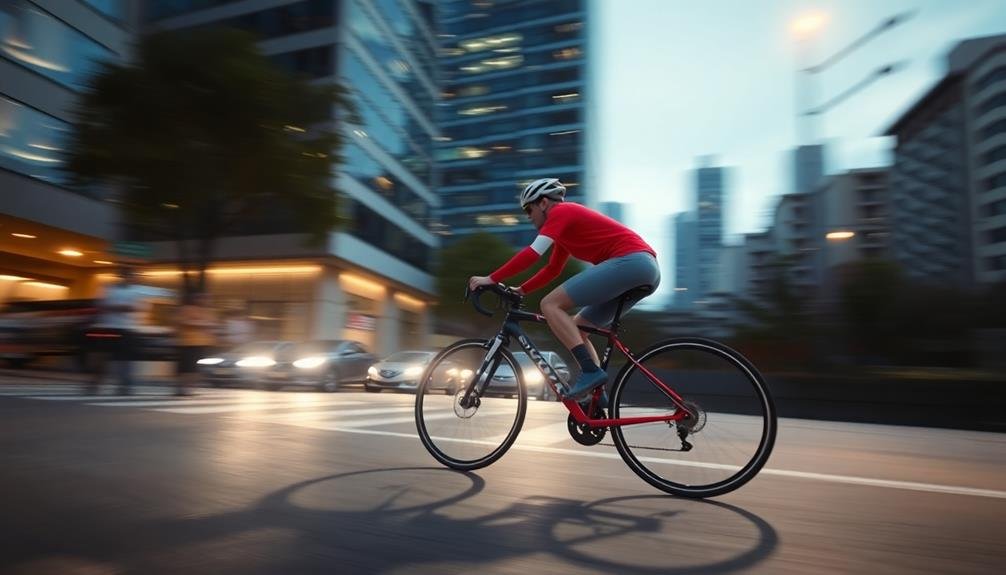
While burst mode freezes action, panning creates a sense of motion in your photos. This technique involves moving your camera along with the subject as it travels across your frame. When done correctly, you'll capture a sharp subject against a blurred background, emphasizing speed and movement.
To master panning on your mobile device, start by selecting a subject moving at a consistent speed, like a cyclist or a car. Set your camera to shutter priority mode if available, or use a third-party app that allows manual shutter speed control. Choose a slower shutter speed, typically between 1/15 and 1/60 of a second, depending on your subject's speed.
Follow these steps to improve your panning technique:
- Stand perpendicular to your subject's path
- Focus on your subject before it reaches you
- Move your phone smoothly, matching the subject's speed
- Continue the movement even after you've taken the shot
Practice is key to perfecting this technique. Experiment with different shutter speeds and subjects to find what works best.
Adjusting Shutter Speed on Smartphones
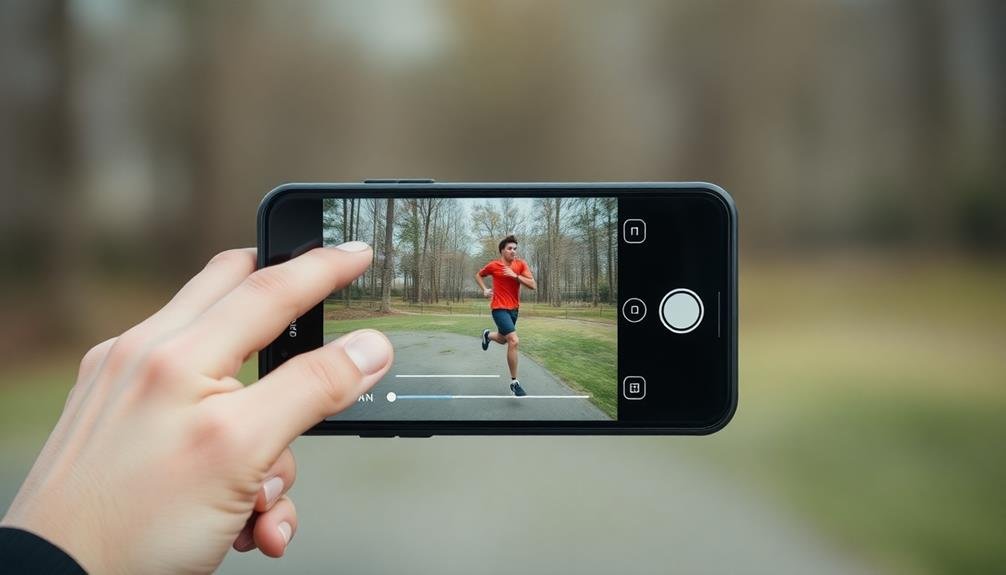
On many smartphones, adjusting the shutter speed isn't as straightforward as on DSLR cameras. However, you can still control this vital setting to capture moving subjects effectively.
Most modern smartphones offer a "Pro" or "Manual" mode in their native camera apps, allowing you to adjust shutter speed. To access this feature, open your camera app and look for the Pro mode option. Once activated, you'll see a shutter speed control, often represented by a fraction like 1/60 or an "S" icon.
Slower shutter speeds (e.g., 1/30 or 1/15) let in more light but may result in motion blur. Faster speeds (e.g., 1/500 or 1/1000) freeze action but require more light.
For moving subjects, start with 1/250 and adjust based on your results. If you're still getting blur, increase the speed. If the image is too dark, decrease it or boost ISO.
Mastering Focus Lock Features

Focus lock is a powerful tool in your smartphone photography arsenal. It allows you to maintain sharp focus on your subject, even as you recompose your shot.
When photographing moving subjects, focus lock becomes especially essential. By tapping and holding on your screen, you'll lock both focus and exposure on your chosen point. This feature is particularly useful when your subject isn't in the center of the frame or when you're dealing with challenging lighting conditions.
To make the most of focus lock:
- Tap and hold on your subject until you see the AE/AF Lock indicator
- Recompose your shot while maintaining the lock
- Release the shutter when you're ready to capture the image
- For continuous focus on moving subjects, enable tracking autofocus if available
Frequently Asked Questions
How Can I Reduce Motion Blur in Low-Light Conditions?
To reduce motion blur in low light, you'll want to increase your shutter speed and ISO. Use a tripod or stabilize your camera against a solid surface. If possible, turn on your camera's night mode or image stabilization feature.
What's the Best Way to Photograph Fast-Moving Animals With a Smartphone?
To capture fast-moving animals with your smartphone, use burst mode and pre-focus on their expected path. Set a fast shutter speed, if possible. Keep your phone steady and anticipate the animal's movement. Good lighting is essential.
Are There Any Apps That Enhance Focus Tracking on Mobile Devices?
You'll find several apps that enhance focus tracking on mobile devices. Try ProCam, Camera+ 2, or FiLMiC Pro. They offer advanced tracking features, letting you lock onto moving subjects and maintain sharp focus throughout your shots.
How Do I Capture Sharp Images of Moving Subjects in Crowded Environments?
To capture sharp images of moving subjects in crowds, you'll want to use burst mode, pre-focus on an anticipated spot, and increase your shutter speed. Don't forget to track your subject's movement and anticipate their path.
Can Smartphone Cameras Effectively Freeze High-Speed Sports Action?
Yes, you can freeze high-speed sports action with smartphone cameras. Use burst mode, pre-focus on the action area, and set a fast shutter speed. Good lighting helps. Practice timing and anticipation for best results.
In Summary
You've now got the tools to capture stunning motion shots on your smartphone. Remember to practice these techniques regularly. Don't be afraid to experiment with different settings and approaches. As you become more comfortable, you'll find yourself instinctively adjusting focus, using burst mode, and panning with ease. Keep pushing your mobile photography skills, and you'll soon be creating professional-looking action images that'll impress everyone. The power's in your hands—go out and start shooting!

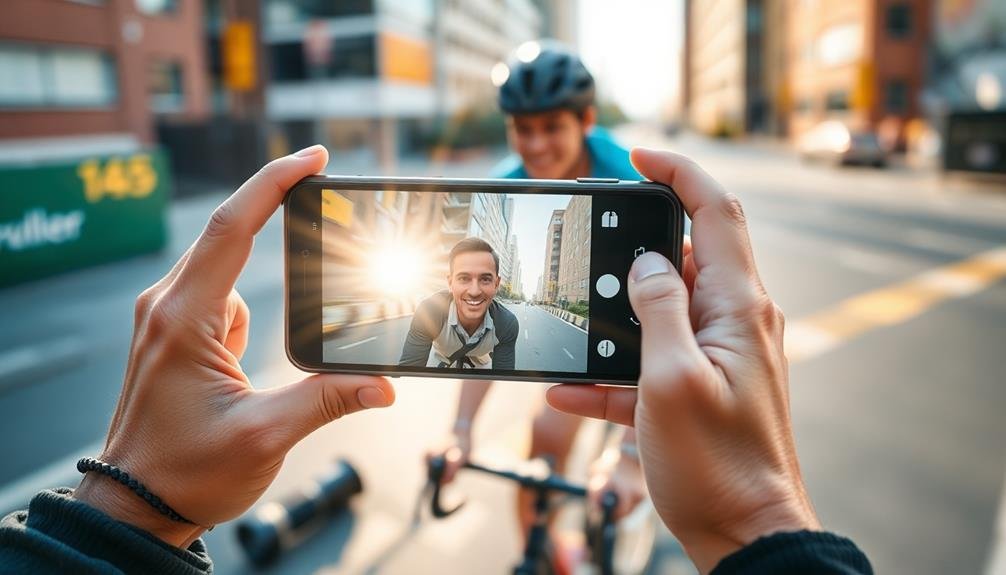



Leave a Reply